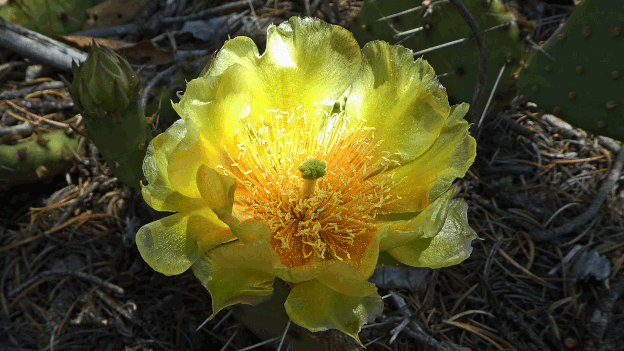New Mexico Wildflowers: Cactus Family
(Cactaceae)
Flowers are arranged alphabetically by genus and species. As you encounter a slide show, can hover your cursor over the images to control them.
Club Cholla (Corynopuntia clavata)
This one is also known as Dagger Cholla. Look for a low mat of cactus where the individual joints are rounded in cross-section. When you look more closely, you'll see that many of the spines are flattened and point slightly backwards.
Cane Cholla (Cylindropuntia imbricata)
While prickly pears have flattened sections, chollas have cylindrical sections. Also, New Mexico's prickly pears tend to hug the ground while the chollas stand up. The cane cholla's yellow-green fruit lingers on the branch long after the flowers are gone. To see a brief YouTube video of deer eating cane cholla fruit, click here.
Scarlet Hedgehog Cactus (Echinocereus coccineus)
In the spring, these low clumps of cactus cast aside their discretion and cover themselves in blazing red. On this page I'll distinguish Echinocereus coccineus (show above) from E. triglochidiatus (shown below). According to The American Southwest, "The only definitive way to distinguish the two species is to analyze their chromosomes." Maybe so, but I've noticed two obvious variants of red-flowered Echinocereus in the Sandia Mountains. I'll refer to those two variants by names often assigned to them, at the risk of being genetically incorrect.
The pictures shown above are from the drier western base of the Sandias, where this cactus always seems to be covered with clusters of many thorns. These correspond to Littlefield and Burns' Scarlet Hedgehog Cactus. They list it as "Echinocereus sp." but also comment, "Often identified as E. coccineus in central New Mexico."
Claret Cup Cactus (Echinocereus triglochidiatus)
My photos of Claret Cup Cactus were taken in pinyon-juniper woodland at the base of the Sandia Mountains, just south of Cedar Crest. I've also seem these cactus at middle elevations on the west side of the Sandias. Unlike the Scarlet Hedgehog Cactus shown above, these cacti have fewer, more widely spaced spines. Please read the disclaimer included in my comments on Scarlet Hedgehog Cactus.
Prickly Pear (Opuntia spp.)
There are four species of prickly pear in the Sandia Mountains, and all can have yellow blossoms. That's my cue to not attempt IDs down to the species level. As these photos show, "yellow" prickly pear blossoms include color variations.
Hair-Spine Prickly Pear (Opuntia polycantha)
The "classic" variety of hair-spine prickly pear is covered with fine spines pointing in multiple directions, giving the pads a distinctly fuzzy appearance. But there are multiple varieties, and I suspect that in May 2016, a prickly pear I found in the Rio Grande Bosque was one of the "not-hairy" varieties (O. polycantha juniperina).


























































